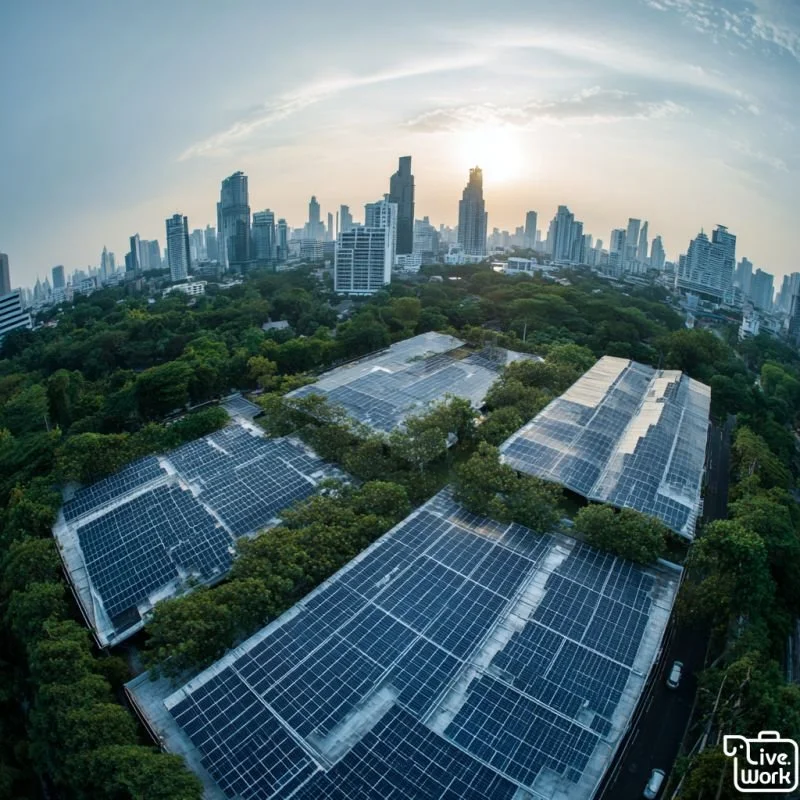Powering the Future: Thailand’s Commitment to Solar Energy and Sustainability
Thailand is shining a light on Southeast Asia’s clean energy future — quite literally. With year-round sunshine and forward-thinking policies, the Kingdom has positioned itself as a regional leader in renewable energy, particularly solar power. What began as a small-scale initiative has evolved into a national movement toward sustainability, energy independence, and environmental stewardship.
In an era defined by climate change and resource depletion, Thailand’s proactive embrace of solar technology not only addresses global challenges but also fosters economic innovation and local empowerment. Let’s explore how the Land of Smiles is turning sunlight into progress.
🌞 Harnessing Thailand’s Solar Potential
Thailand enjoys an average of 2,000 to 2,500 hours of sunlight per year, making it one of the most solar-rich countries in Asia. The country’s tropical climate provides ideal conditions for photovoltaic (PV) systems, which convert sunlight into electricity efficiently throughout the year.
From the Central Plains to the Northeastern Plateau (Isaan), solar farms are now common sights, their glimmering panels reflecting both sunlight and Thailand’s determination to transition toward a greener future.
These developments contribute significantly to the Alternative Energy Development Plan (AEDP) — Thailand’s long-term strategy for increasing renewable energy use and reducing dependence on imported fossil fuels.
⚙️ Government Policies Driving the Transition
Thailand’s success in solar energy didn’t happen by chance; it’s the product of strong policy frameworks and government commitment. Several key initiatives have catalyzed growth in the sector:
🔹 1. The Alternative Energy Development Plan (AEDP 2018–2037)
This roadmap aims for renewable energy to account for 30% of total energy consumption by 2037, with solar expected to play a leading role.
🔹 2. Feed-in Tariff (FiT) Programs
Introduced to incentivize investment, FiTs guarantee favorable purchase prices for solar-generated electricity, making solar farms and rooftop installations financially viable.
🔹 3. Private Sector Partnerships and PPP Models
The Thai government actively encourages public-private collaborations, facilitating capital inflows from both domestic and foreign investors.
🔹 4. Community Solar Projects
New initiatives empower rural communities to produce and sell their own solar energy, democratizing energy production and fostering local resilience.
These policies have positioned Thailand as a top solar power producer in ASEAN, setting benchmarks for its neighbors.
☀️ The Rise of Solar Farms Across Thailand
Thailand’s solar capacity has skyrocketed over the past decade. From the massive Lopburi Solar Farm — one of the largest in Southeast Asia — to smaller community-driven installations in Chiang Mai and Nakhon Ratchasima, solar projects are transforming both the landscape and livelihoods.
🌿 Key Examples:
Lopburi Solar Farm: Produces more than 80 MW of power, enough to supply tens of thousands of homes.
Ratchaburi Solar Project: Integrates advanced tracking systems to optimize sunlight absorption throughout the day.
Chiang Mai University Solar Park: Serves as a model for integrating renewable energy with educational research.
Each project contributes to reducing Thailand’s carbon footprint and generating clean, affordable power for households and industries alike.
💡 Economic and Social Impact
Solar energy is not only an environmental solution but also an economic catalyst.
💼 Job Creation
From installation and maintenance to manufacturing and research, the solar industry supports thousands of jobs — particularly in rural areas where new solar farms are being developed.
💰 Reduced Energy Costs
Solar energy helps stabilize electricity prices by reducing dependence on imported oil and gas. For businesses, especially in manufacturing, it offers long-term savings and energy security.
🤝 Empowering Communities
Local solar cooperatives and community farms allow residents to participate directly in energy generation — creating income streams while fostering energy independence.
🌎 Environmental Benefits and Climate Goals
Thailand’s pivot toward solar energy plays a crucial role in meeting its Net Zero Emission Target by 2065. The environmental benefits are vast:
🌤 Reduced Greenhouse Gas Emissions: Solar energy emits zero carbon during operation, significantly lowering the national carbon footprint.
🌳 Preservation of Natural Resources: By decreasing reliance on fossil fuels, solar energy reduces land degradation and pollution.
💧 Conservation of Water Resources: Unlike thermal power plants, solar farms require minimal water, supporting Thailand’s sustainability efforts in water-scarce regions.
Through these measures, Thailand is not only protecting its environment but also contributing to global climate goals under the Paris Agreement.
⚡ Rooftop Solar and Smart Energy Innovation
Beyond large-scale farms, rooftop solar installations are becoming increasingly popular among urban households, factories, and hotels. This decentralized model transforms consumers into “prosumers” — producers and consumers of energy.
Smart grid systems and digital monitoring technologies are helping Thailand integrate renewable energy more efficiently into the national grid. These innovations ensure stable energy delivery even as renewable sources fluctuate with weather conditions.
🚀 The Future: Thailand’s Solar Ambition
Thailand’s renewable energy ambitions don’t stop here. The next decade will see significant growth in:
Floating solar farms on reservoirs and dams, combining hydropower and solar energy.
Battery storage innovations, ensuring consistent power supply even after sunset.
Hybrid energy systems integrating solar, wind, and biomass for greater efficiency.
The Sirindhorn Dam Floating Solar Project, the largest of its kind in the world, symbolizes this future — blending technology, sustainability, and Thai ingenuity.
✨ Why It Matters
Thailand’s solar revolution is more than a technological shift — it’s a statement of responsibility, innovation, and hope. The country’s leadership in clean energy demonstrates that economic growth and environmental care can coexist.
By embracing solar power, Thailand isn’t just lighting up homes — it’s illuminating the path toward a sustainable, equitable, and resilient future.
🌍 Final Thoughts
As the world races toward renewable energy, Thailand’s story offers inspiration for other emerging economies: progress grounded in vision, policy, and community participation.
Supporting solar initiatives — whether through investment, policy advocacy, or simple awareness — is essential for sustaining this momentum. Together, we can ensure that the bright future powered by the Thai sun shines for generations to come.
